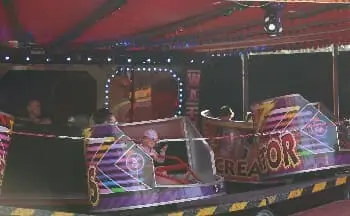The Waltzer, History Of An Iconic Ride
One of the mainstays for any British funfair is the Waltzer. Indeed so popular is this particular ride that you will struggle to find any but the smallest funfairs without one.
Similar in style to the Noah’s Ark ride, i.e., a platform that rotates at high speed and undulates over a number of hills to give an up and down motion. The difference is the ark originally had various animals to sit on, then evolved to have motorbikes, probably around the time that motorbikes became popular with young people. This led in some places to them becoming more popularly known as speedways. As most early rides were these tended to be ornately decorated.
The waltzer by contrast has tub shaped cars, that are attached by either a slew ring or a pivot point to the platform. As the ride rotated, the riders all sat at one end of the car would unbalance it and it would begin to spin. The attendants on the ride would walk the platform as it rotated spinning the cars by hand to make them faster. With attractive young ladies tending to be spun the most.

Early History
The very first evidence we have for the ride, is a 1920’s model built by one Dennis Jeffries of Congleton. Posterity records the very first passengers as being his nieces Phyllis and Dolly Booth, nothing like using family as Guinee pigs. A tradition which continues today, a few years back a relative building his own ghost train had put the first car together, but wasn’t sure if the gearing was correct. He put his old dad in as a crash test dummy and set it in motion. The car accelerated along the track like an exocet missile, jumped the rails at the first corner and set off into infinity and beyond. Luckily said dad fell off at this point. No amount of cajoling could convince him to try the mark two car.
Maxwell And Sons
The sadly now defunct Scottish firm of Maxwell and Sons, based in Musselburgh, became perhaps the best known manufacturer of the ride in the UK producing some 59 examples of the ride. Waltzers tended to have ten cars, though as the ark/speedway fell out of fashion a number of these were converted to waltzers so there are both nine and eleven car examples.
H.P. Jacksons
The biggest rival to Maxwells was the Congleton based firm of Jackson’s who produced 29 rides. They kept going a little longer than Maxwells producing their last ride in 1992. (Maxwells were out of business by 1983)
A number of other firms produced waltzers, but only in very small numbers.
Fairtrade Services
Waltzers were always an extremely labour intensive ride to set up and derig. A handful of examples were converted to pack on an artic load to reduce the set up time. A showmen by the name of Robert Porter, who was experienced in refurbishing and repairing waltzers. Took this a step further with a design for a new ride, made from the start to be a more compact travel load and quicker set up.
Under the brand of Fairtrade Services he has now produced 21 examples. They are on track to surpass Jackson’s as the second most prolific manufacturer.
One particularly striking example of a ‘Porter Waltzer’ as they are more commonly referred to, is the example above. Built for the Norwegian firm of Lund’s Tivoli. With Aasmund Lund at the helm, the firm commissioned this ride. With it’s stunning fireball theme, around the back of the ride are numerous led screens that provide a fire effect.
It is unusual that although the ride is one of the most popular in the UK, it is seldom seen on the continent. Raymond Codona Jnr travelled his Hell Raiser waltzer in Holland for a number of seasons. Very successfully, but you find few native examples.
Tilt-A-Whirl
Across the pond Herbert Sellner invented a similar ride called the Tilt-A-Whirl in 1926. Similar in motion to the waltzer this type only has seven cars, but otherwise works in much the same way.
The most noticeable difference, is that the waltzer has a roof and is an enclosed ride. Add in the sound and lighting systems and they are much like a portable nighclub. The tilt a whirl by contrast is an open topped ride. To be honest looks very much like an home made waltzer.
The Waltzers
The waltzer is an enduring icon of the British fairground scene. One change to its detriment is are the current health and safety laws. Waltzers were renowned for having the gangway around the edge of the ride packed with people. It truly was a social event, with many a couple meeting on the waltzers (Kevin Keegan the England football star was one, meeting his wife on Dowses waltzer at Scunthorpe). Sadly young people nowadays aren’t considered responsible enough to stand on he gangway a few feet from the spinning platform so now the ride is closed off whilst it is in motion.
Sources;
National Fairground and Circus Archive
Wikipedia Waltzers Originally Had 10 Cars

26 June 2021
You also forgot to mention ARM built around 30 n most were 1 load machines which Fairtraid took alot of the ARM design when they started building their’s
1 July 2021
Yep you are absolutely correct. We might have an article on ARM in the near future if there is any interest in it.
28 July 2021
An article on ARM would b e welcome as I am trying to establish exactly how many ARM Waltzers were built.Having asked those involved with ARM they state approximately 30 but there appear to be no records kept by ARM.
As you probably know a lot of the ARM Waltzers particularly those built for Scandinavian operators were similar in appearance and colour so establishing the precise number is difficult.The Scandinavian enthusiasts do not allocate machine numbers as in the UK but refer to them by colour or the 7th ARM Waltzer to arrive in Scandinavia and some of the larger operators ie Axels have had /or still own several Waltzers.
14 August 2021
I would imagine it will be difficult to get a precise number, I doubt ARM would tell you even if they knew lol. The enthusiasts are usually pretty accurate on things like that so the number stated will be somewhere near.